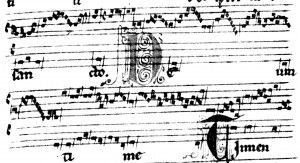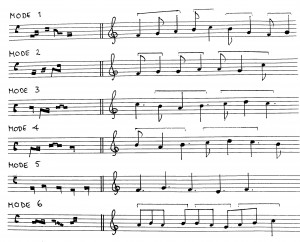So what exactly is Organum Duplum?
Here is the opening of the same piece (‘Deum Time’) in the original notation:
On this webpage you will find explanations and definitions to help you come to grips with the music from the Notre Dame School: a body of music that profoundly influenced the evolution of Western European music.
Although Notre Dame School polyphony emerged from an improvisatory tradition, it produced the first body of polyphonic works to be recorded primarily in writing rather than orally. As a result, many theoretical writers of the time were able to study and analyse it. The music was known as ‘musica mensurabilis’, or ‘measured music’, and, for the first time, a system was devised whereby rhythmic values could be indicated by the manner in which the music was written down. Rhythmic meaning was conveyed by the number of notes in a ligature and the position of the ligature among other ligatures. Perhaps inevitably, however, given the system’s youth, the rhythmic rules pertaining to Notre Dame School polyphony are not always clear, and its rhythmic interpretation remains open to debate (see my note on modal rhythm below).
Definitions
- Notre Dame School polyphony flourished in Paris between 1170 and 1250. There are three main forms or ‘genres’ of composition: organum, conductus and motet.
- A Magnus Liber Organi, or ‘great book of organum’, was referred to in the writings of 13th century theorists. It was designed for the liturgy of Notre Dame Cathedral in Paris and was probably compiled from around 1170. According to the English scholar now known as ‘Anonymous IV’, Léonin was the main original composer of organum duplum. His work was supplemented by his successor Pérotin, who was described as a master in the discantus style. The Magnus Liber Organi itself no longer exists. What we do have are three main manuscripts that are thought more or less to reflect the book’s original contents. There is now also a seven-volume modern edition, called the ‘Magnus Liber Organi’, which contains transcriptions of all the two- three- and four-part organa from the three main manuscript sources (Editions de l’Oiseau Lyre, general ed. Edward H. Roesner (1993 – 2009)). However, the conductus and motets from the original manuscripts are not transcribed in this edition.
- Organum has been given different meanings. It is sometimes used as a collective word for all polyphony, or with the general meaning of all ‘measured’ music. (Thus the word ‘organi‘ in the title of the original Magnus Liber Organi seems to refer to works in all three of the Notre Dame School genres.) However, during the 12th century, ‘organum‘ also acquired a specific meaning, being used to describe in particular polyphonic music based on sustained-note counterpoint (sometimes called organum in speciali). From the second half of the 13th century it was being used to describe polyphonic settings of plainchant, to distinguish them from other types of polyphony that was not based on plainchant (conductus and motet). Notre Dame School polyphony includes organum in two, three and four parts. The word organum can refer either to the musical genre or to a particular work in that genre. If used to describe particular works the plural ‘organa’ can be used.
- Organum duplum is two-part organum that sets the solo sections of responsorial chants from either the Offices or the Mass. An elaborate and charismatic upper voice weaves intricate patterns above the appropriate plainchant, which is sung in extended note values by the lower voice, or ‘tenor’. The resultant grand, ecstatic settings were sung on important feast days.
- Organum triplum and organum quaduplum are, respectively, three-and four-part organum.
- Organum purum, also called organum per se is used to describe passages of organum duplum where the tenor holds sustained notes and where no particular modal rhythm is apparent.
- In discantus passages of organum duplum, both the upper voice and the tenor are rhythmically active. The tenor often has repeating rhythmic patterns and establishes a more or less regular pulse.
- Copula is a tricky term to define. The 13th century theorists are neither clear nor consistent. In the treaty mensurabili musica it is described as ‘between discantus and organum‘, but what this actually means is open to interpretaton. In so far as it applies to organum duplum, copula has been used to describe a passage where the tenor has sustained notes but the upper voice moves in a recognizable modal rhythm.
- In the context of organum duplum, a clausula is a passage in discantus style written as an alternative to an original section of organum purum which can thus be inserted as a substitute passage. Pérotin was described by Anonymous IV as the best composer of clausulae.
- A ligature is two or more notes grouped together. It came to define by its shape the notes’ rhythm (see below).
- The modal rhythms were first described in the treaty mensurabili musica (c. 1240) formerly attributed to Johannes de Garlandia. They allowed rhythmic meaning to be conveyed by the number of notes in a ligature and the position of the ligature among other ligatures. Six different ligature patterns were described, each of which implies a different rhythm.
The English scholar ‘Anonymous IV’ added reference to a further seven irregular rhythmic modes. It should be remembered that the theorists imposed a rhythmic system of music that itself pre-dated the theory and was originally an improvised form.
While discantus and copula passages will usually fit (more or less) into a modal rhythm, organum purum passages will not. However, even organum purum passages can be interpreted with reference to the modes; the way in which the ligatures are written will promote particular rhythmic choices.
- A plica is a note with stems on both sides of the notehead. It is sung with two pitches: the first is specified by the notehead, the second is unspecified but lies just above or below the first, depending on the direction of the stem. The plica has its origins in the plainchant liquescent neume, where a consonant is the reason for the second pitch-unspecific note. In Notre Dame School polyphony, plicas sometimes occur as an ornament even when there is no attributed consonant.
- Currentes is the name of a group of descending diamond-shaped notes. Where the group contains more than two diamond-shaped notes, the notes are usually sung quickly and more or less equally.

